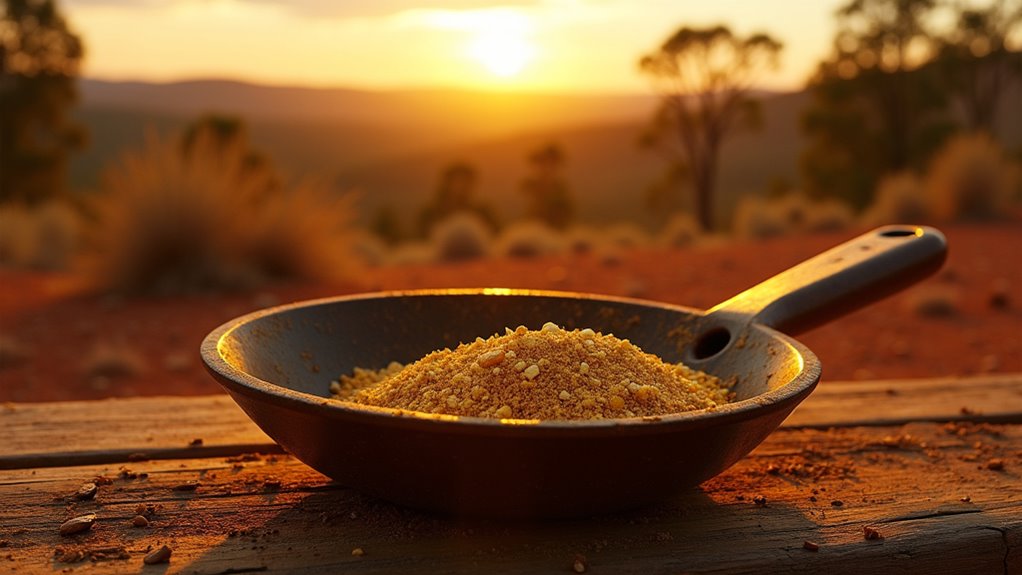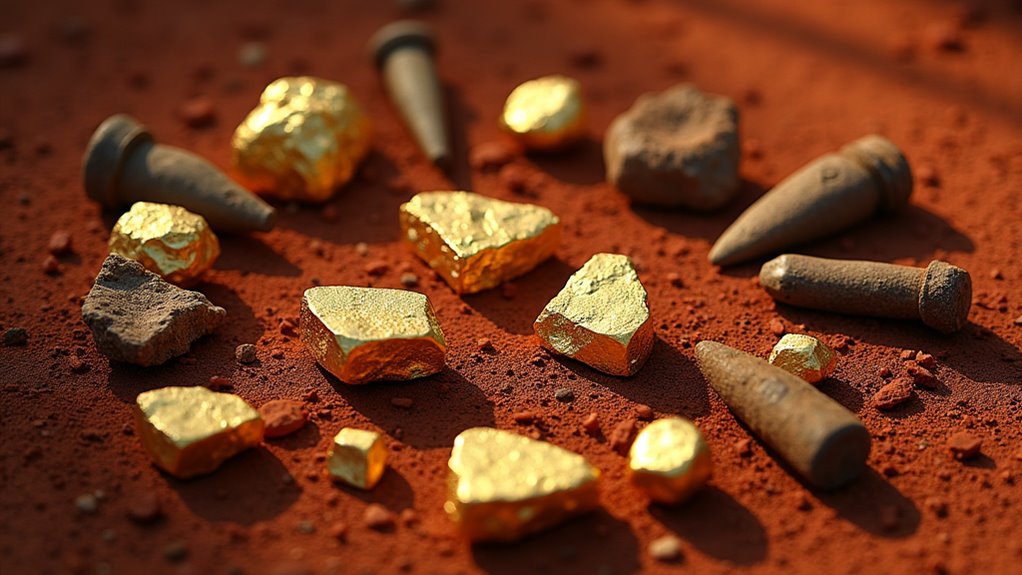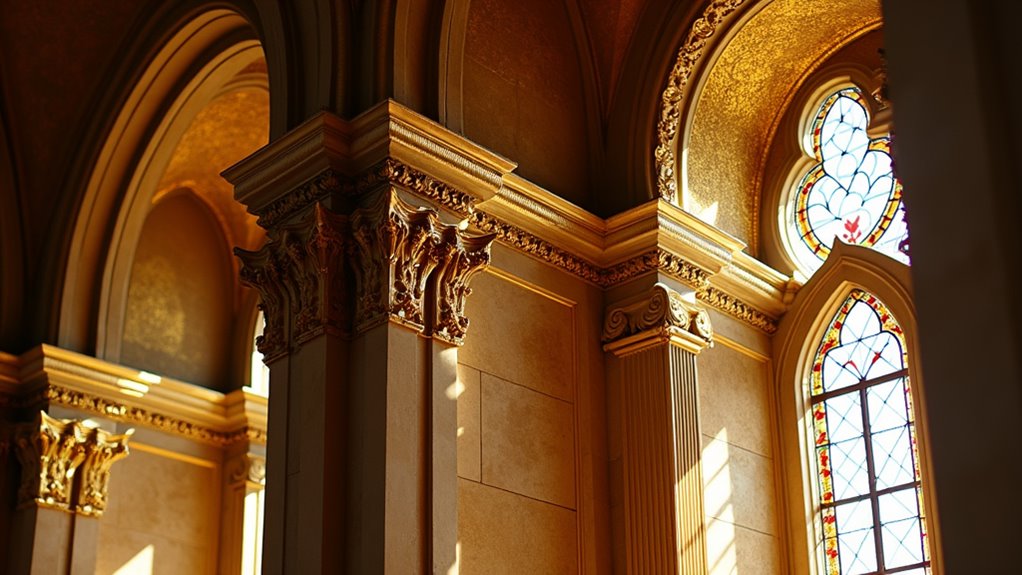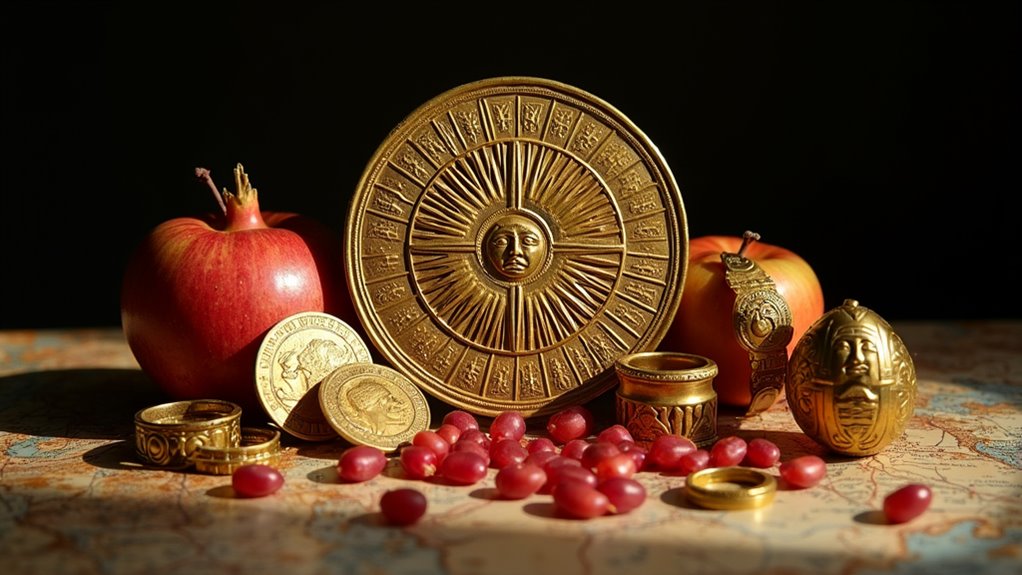Gold held profound significance in Pre-Columbian civilisations, representing divine power and serving as a sacred bridge to supernatural domains. Ancient American societies developed sophisticated goldworking techniques, including smelting, alloying, and lost-wax casting, with distinct regional specialities emerging. Colombian craftsmen excelled in casting while Peruvian artisans mastered sheet metal work. Trade routes facilitated the exchange of materials and expertise throughout the Americas, establishing gold’s enduring cultural and spiritual importance. These ancient practices reveal fascinating insights about Pre-Columbian innovation and beliefs.

Shimmering beneath the surface of Pre-Columbian history lies a legacy of gold that transcends mere precious metal. In ancient American civilizations, gold represented far more than material wealth – it embodied divine power, serving as a sacred bridge between earthly existence and supernatural domains. This precious metal’s resistance to decay and its brilliant luster made it a perfect symbol of immortality and authority, particularly among societies that associated it with the sun’s divine energy. The ethical implications of gold sourcing have become increasingly relevant today, as consumers seek responsibly sourced gold that honors these ancient traditions. Furthermore, the modern emphasis on ethical gold sourcing aligns with the reverence these cultures held for the material, reflecting a growing awareness of sustainable practices that protect both people and the planet. Gold plated connectors are an example of how the enduring properties of gold continue to be valued in various applications today.
Archaeological evidence reveals sophisticated goldworking traditions dating back to 2155-1936 BCE in the Andes, where early artisans initially gathered gold nuggets from streams for creating body ornaments. As techniques evolved, Pre-Columbian societies, particularly in South America, developed advanced metallurgical practices that included smelting and alloying – processes distinctly different from those in North America. The Cupisnique and La Tolita cultures emerged as pioneering forces in sophisticated goldwork between 1500-400 BCE.
Early Andean artisans mastered goldworking millennia ago, transforming simple stream-gathered nuggets into sophisticated metallurgical traditions that spread across ancient South America.
The technical mastery of Pre-Columbian goldsmiths manifested through various methods, with lost-wax casting enabling the creation of intricately detailed pieces. Hot and cold hammering techniques predated widespread smelting practices, while Colombian craftsmen became renowned for their exceptional casting abilities in producing ceremonial items. Peruvian artisans, meanwhile, specialized in manipulating sheet metal to achieve complex forms.
Regional variations in goldworking reflected distinct cultural approaches and available resources. The Andean civilizations, including the Moche and Chavín, incorporated gold extensively in their rituals and elite burials. Central American societies adopted goldworking later, following contact with South American cultures, while the Aztecs, despite their relatively late mastery of the craft, demonstrated remarkable innovation in their ornamental designs.
The ceremonial significance of gold permeated Pre-Columbian societies. Colombian ritualists believed in the metal’s ability to absorb solar energy, deliberately exposing golden objects to sunlight to enhance their symbolic power. Sacred spaces often featured gold artifacts, while burial practices included golden objects to signify the deceased’s divine connections. Some cultures even practiced ceremonial destruction of gold items, believing this released their sacred essence back to the cosmos.
Trade routes played an essential role in the distribution of gold throughout the Americas, with South American sources supplying materials northward into Central America and Mesoamerica. Ecuadorian maritime traders facilitated this exchange, contributing to the spread of both raw materials and technical expertise. This network of trade enabled the development of diverse regional styles and techniques, while maintaining gold’s consistent status as a material of profound spiritual and cultural importance throughout Pre-Columbian civilizations.
Through this rich tapestry of technical innovation, cultural significance and trade, Pre-Columbian gold working stands as a reflection of the sophisticated understanding these ancient societies possessed of both the practical and spiritual dimensions of this extraordinary metal. Additionally, the influence of ancient goldsmithing techniques can still be seen in contemporary jewelry design, highlighting the enduring legacy of these early artisans.
Frequently Asked Questions
How Did Ancient Americans Determine the Purity of Their Gold?
Ancient American civilisations employed several methods to test gold purity, similar to other ancient cultures.
They primarily relied on visual assessment of colour and lustre, alongside basic touchstone testing.
Fire assaying was also practised, particularly in more advanced societies.
The specific gravity method, using water displacement, helped determine purity levels.
These techniques, while less sophisticated than modern methods, proved remarkably effective for their time.
What Tools Were Specifically Used to Mine Gold in Pre-Columbian Times?
Pre-Columbian miners relied on a diverse set of tools for gold extraction.
Stone hammers and hammerstones with wooden handles were essential for breaking rocks, while bone scrapers enabled precise extraction work.
Wooden digging sticks and wedges helped loosen soil and rock seams. They transported materials using baskets and ropes made from vegetal fibres.
Copper tools complemented stone implements, and ocote-torches provided vital illumination in dark mining environments.
Did Pre-Columbian Civilizations Have Designated Storage Facilities for Their Gold?
Pre-Columbian civilisations didn’t maintain formal vaults like those familiar to us today, but they did have sophisticated storage systems.
Archaeological evidence shows they primarily stored gold in temples, elite residences, and hidden caves. Religious spaces were particularly important, as priesthoods controlled valuable ceremonial objects.
Elite members of society also maintained private repositories within their palaces, whilst some communities used isolated mountain caves for safekeeping during turbulent times.
How Did Weather Conditions Affect Gold Mining in Different Regions?
Weather conditions greatly impacted pre-Columbian gold mining across different regions.
In tropical areas, heavy rainfall caused erosion and dangerous riverbank conditions, while drought in arid highlands limited water availability for sluicing.
The Andean regions faced challenges from cold temperatures and hazardous rockslides.
Temperate zones, like central Mexico, provided more stable conditions.
Dense fog in mountainous areas corroded tools, while seasonal flooding in lowlands disrupted mining operations and access.
Were There Specific Rituals Performed Before Starting Gold Extraction Processes?
Pre-extraction rituals were fundamental to ancient mining practises.
Miners would often make offerings to earth deities, believing this would protect them from spiritual consequences of disturbing sacred ground.
Common rituals included the chewing of coca leaves, purification ceremonies, and periods of fasting.
Some societies required spiritual specialists to bless mining sites and perform ceremonies at sacred locations like hilltops or caves before extraction could commence.














